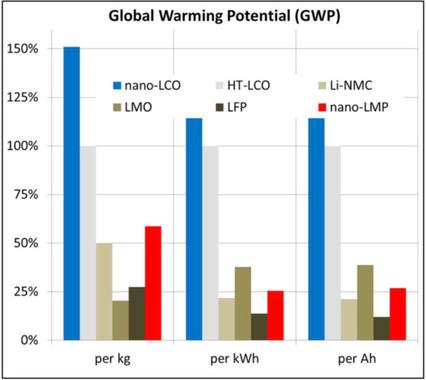当前位置:
X-MOL 学术
›
ChemSusChem
›
论文详情
Our official English website, www.x-mol.net, welcomes your feedback! (Note: you will need to create a separate account there.)
Early‐Stage Sustainability Evaluation of Nanoscale Cathode Materials for Lithium Ion Batteries
ChemSusChem ( IF 8.4 ) Pub Date : 2018-06-10 , DOI: 10.1002/cssc.201800109 Roland Hischier 1 , Nam Hee Kwon 2 , Jean-Pierre Brog 2 , Katharina M. Fromm 2
ChemSusChem ( IF 8.4 ) Pub Date : 2018-06-10 , DOI: 10.1002/cssc.201800109 Roland Hischier 1 , Nam Hee Kwon 2 , Jean-Pierre Brog 2 , Katharina M. Fromm 2
Affiliation

|
Results of an early‐stage sustainability evaluation of two development strategies for new nanoscale cathode materials for Li‐ion batteries are reported: (i) a new production pathway for an existing material (LiCoO2) and (ii) a new nanomaterial (LiMnPO4). Nano‐LiCoO2 was synthesized by a single‐source precursor route at a low temperature with a short reaction time, which results in a smaller grain size and, thereby, a better diffusivity for Li ions. Nano‐LiMnPO4 was synthesized by a wet chemical method. The sustainability potential of these materials was then investigated (at the laboratory and pilot production scales). The results show that the environmental impact of nano‐LiMnPO4 is lower than that of the other examined nanomaterial by several factors regardless of the indicator used for comparison. In contrast to commercial cathode materials, this new material shows, particularly on an energy and capacity basis, results of the same order of magnitude as those of lithium manganese oxide (LiMn2O4) and only slightly higher values than those for lithium iron phosphate (LiFePO4); values that are clearly lower than those for high‐temperature LiCoO2.
中文翻译:

锂离子电池纳米正极材料的早期可持续性评估
报道了锂离子电池新型纳米级正极材料的两种开发策略的早期可持续性评估结果:(i)现有材料的新生产途径(LiCoO 2)和(ii)新型纳米材料(LiMnPO 4))。纳米LiCoO 2是在低温下通过单源前体路线合成的,反应时间短,这导致了较小的晶粒尺寸,从而对锂离子具有更好的扩散性。纳米LiMnPO 4是通过湿化学方法合成的。然后研究了这些材料的可持续发展潜力(在实验室和中试规模)。结果表明,纳米LiMnPO 4的环境影响与用于比较的指示剂无关,它比其他被检查的纳米材料低几个因素。与商用阴极材料相比,这种新材料特别是在能量和容量方面显示出与锂锰氧化物(LiMn 2 O 4)相同数量级的结果,并且其值仅比磷酸锂铁高。 (LiFePO 4);该值明显低于高温LiCoO 2的值。
更新日期:2018-06-10
中文翻译:

锂离子电池纳米正极材料的早期可持续性评估
报道了锂离子电池新型纳米级正极材料的两种开发策略的早期可持续性评估结果:(i)现有材料的新生产途径(LiCoO 2)和(ii)新型纳米材料(LiMnPO 4))。纳米LiCoO 2是在低温下通过单源前体路线合成的,反应时间短,这导致了较小的晶粒尺寸,从而对锂离子具有更好的扩散性。纳米LiMnPO 4是通过湿化学方法合成的。然后研究了这些材料的可持续发展潜力(在实验室和中试规模)。结果表明,纳米LiMnPO 4的环境影响与用于比较的指示剂无关,它比其他被检查的纳米材料低几个因素。与商用阴极材料相比,这种新材料特别是在能量和容量方面显示出与锂锰氧化物(LiMn 2 O 4)相同数量级的结果,并且其值仅比磷酸锂铁高。 (LiFePO 4);该值明显低于高温LiCoO 2的值。



























 京公网安备 11010802027423号
京公网安备 11010802027423号